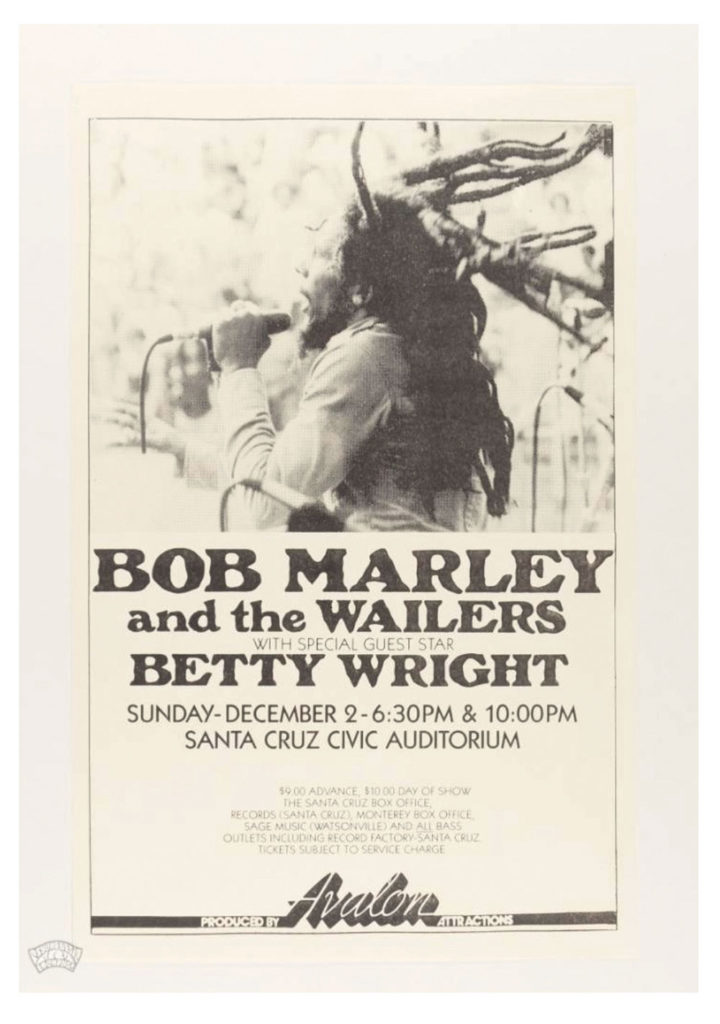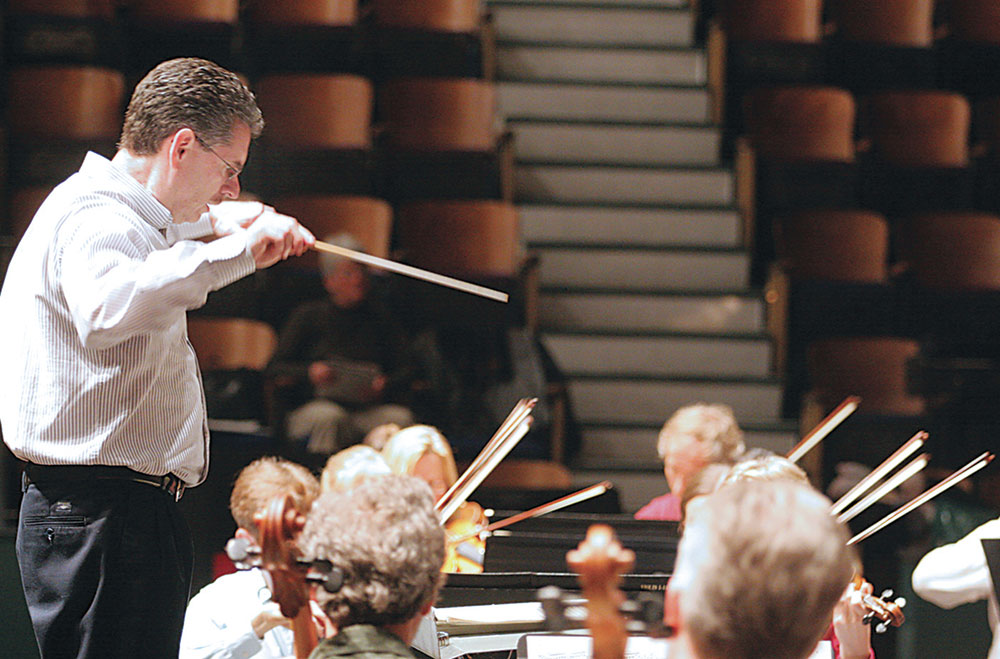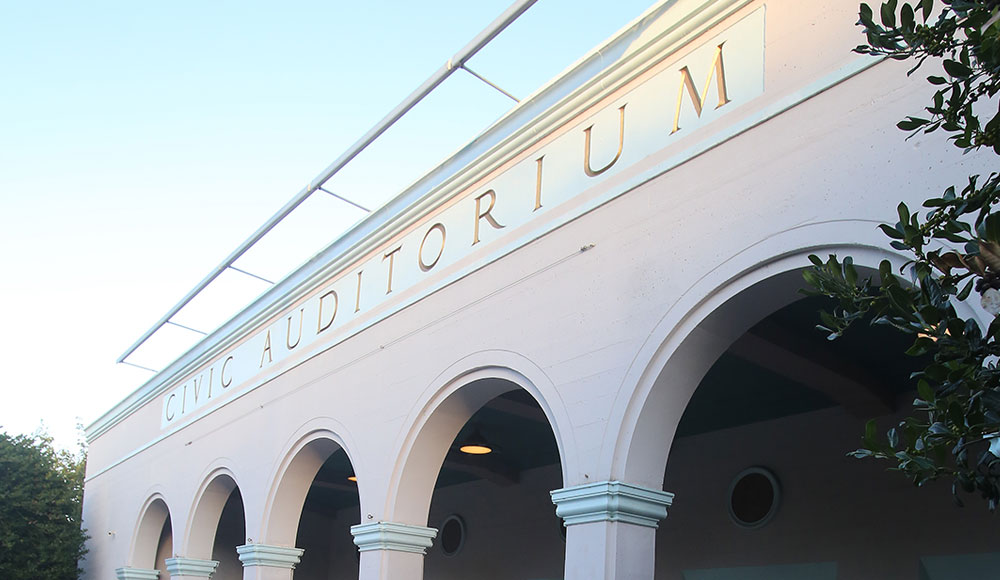The Santa Cruz Civic Auditorium drains more than half a million dollars from the city’s budget each year. But the real problem is that the city spends about $10,000 a week for the building to sit empty. On most nights, the 85-year-old landmark is a ghost.
It wasn’t always this way. To understand what we stand to lose, you have to travel back to its birth in 1940. America was clawing its way out of the Great Depression, powered by the New Deal—a radical belief that the government could invest directly in its people and places. The Works Progress Administration wasn’t just about creating jobs; it was about building monuments to a shared future. And in Santa Cruz, it built the Civic.
Imagine walking through its doors for the first time then. You would have felt the solid weight of the handles, smelled the fresh plaster and paint, and seen the light gleaming on polished concrete floors. Look up, and the vast, curved ceiling would have arched over you, not just as a roof, but as a promise. This wasn’t a private club; it was a cathedral of civic hope, built by and for the community. The air didn’t hold the silence of emptiness, but the hum of possibility. It was a declaration in steel and concrete that said, “We believe in this place. We believe in each other.”
In its heyday you could see internationally known acts, including Bob Dylan, Bob Marley, the Clash, Tom Petty & the Heartbreakers, the Ramones, Talking Heads, Smashing Pumpkins, Shakti and Ozzy Osbourne.
Flash forward 85 years, and that vibrant promise feels faded. The magnificent ceiling is still there, but it covers more empty nights than sold-out shows. The vastness that once felt like possibility can now feel like neglect. The silence is no longer hopeful; it’s the sound of missed opportunities.
The building’s modern story is told by a different set of numbers. It has a math problem. According to the City of Santa Cruz’s own budget, the Civic once recovered up to 80 percent of its operating costs. Today, that number has slipped below 50 percent. The city’s adopted FY 2025 budget shows the Civic Auditorium Fund requires a transfer of $564,303 from the General Fund to cover its operational shortfall. That is what it costs to maintain the ghost.

The Anatomy of a Decline
The Civic’s slide hasn’t been the result of a single catastrophe, but a slow erosion, a story told in the quiet language of budget documents and deferred decisions.
Inside the city’s Capital Improvement Program (CIP), a multi-year plan for infrastructure projects, the Civic appears repeatedly next to the words “unfunded” or “deferred.” A 2023 facilities report noted that its main barrel roof has reached its projected end-of-life. The item was flagged but pushed into future planning.
A modest request for a new $62,000 sound system was acknowledged in 2021 but never funded; in some documents, the line item disappears without explanation. A comprehensive $12 million renovation, addressing seating, seismic safety, lighting and accessibility, has remained a fantasy on paper for years.
City Council transcripts reveal a similar pattern. When the Civic is discussed in budget hearings, it’s often in the context of service reductions. In 2020, temporary event staff positions were cut. The move was described as a temporary measure, but those roles have not been restored, quietly lowering the building’s operational capacity. Revenue targets have also been lowered, from a projection of nearly $700,000 in a 2018 memo to the current reality of under $500,000. This reflects a quiet resignation to diminished performance.
The real-world consequences are clear. Archived booking calendars show the venue hosted over 180 event days in 2015; that number has now fallen below 130. Veteran promoter Eddy Dees, who learned under the Catalyst’s Gary Tighe, says a big reason is the city’s 5% admissions tax—enacted after the 1989 Loma Prieta earthquake as a short-term measure but never retired. The surcharge, unique in the region, adds cost for audiences and overhead for promoters, making Santa Cruz a harder sell compared to nearby markets. “It helps keep people away,” Dees says. “It’s not the staff—it’s decades of bad decisions.” On a $50 ticket, the tax adds $2.50; for a 1,200-seat show, it’s $3,000 tacked on to the event cost. For touring acts working with tight margins, that can be enough to skip the Civic—and for local cultural presenters, it can feel like a built-in penalty for bringing entertainment to town.
The fact that the tax has lasted more than three decades shows how a “temporary” fix can quietly become permanent. City leaders have never revisited whether it still serves its original post-earthquake purpose—and in a competitive live-music market, that absence of review can influence which acts choose Santa Cruz and which ones pass it by.
A Venue Out of Step
Local promoters and festival organizers, many speaking off the record, confess they’ve tried to book the Civic. They cite a history of unpredictable labor rules, outdated booking systems and a slog of bureaucracy that stifles creative risk. As one veteran producer sighed, “If I can book the Fox in Oakland in half the time, why keep begging for Santa Cruz? We love the place, but it isn’t set up for growth.”

Voices from the Inside
Gary Reece, executive director of the Santa Cruz Symphony, has lived this reality for years. He’s not a musician; he’s a former banker and turnaround specialist, a professional hired to rescue struggling ventures from the brink of failure. He was brought in to keep the symphony solvent, and he’s blunt about the challenges posed by its home venue.
[Editor’s note, Aug. 13, 2025: Good Times in no way meant to imply that the symphony is not solvent—only that Mr. Reece has the background to ensure that the organization continues to stay solvent. Reece shared more details on his background: Having served for many years as treasurer of the Santa Cruz Symphony’s board, he became executive director after his predecessor retired and an interim director stepped down. He brings a strong background in finance and management, and under his leadership the Symphony continues to thrive—presenting full seasons, attracting guest artists, and running a fully donor-funded program that brings nearly 4,500 local students to their first classical concert each year. He’s one of several voices advocating for a Civic that works better for audiences and performers. “This isn’t about rescuing the Symphony,” he emphasizes. “It’s about making the Civic a place that inspires.”]
“We’re performing on a basketball court,” he says plainly, referencing the flat floor that serves as the main stage. “That’s not hyperbole. It’s a fact.”
This isn’t a new conversation. Back in 2017, Good Times reported on a community push to renovate the Civic. Then-Mayor David Terrazas stated, “This building is intended to present the best of Santa Cruz’s past, present and future … the facility is letting down the performers and guests. The Civic is not living up to its potential currently.” At the same event, Cabrillo Festival Executive Director Ellen Primack warned that the aging facility was becoming a barrier to access. “The seating is becoming a deterrent to cultural participation. … People choose between beautiful facilities over the hill and coming here,” she said. Years later, Gary Reece is echoing the same frustrations.
On the other side of the desk is Tremain Jones, the city’s civic supervisor and superintendent of recreation. He sees the building through a different lens. “The Civic isn’t a loss,” he insists. “It’s a public good.”
Jones points out that the Civic hosts city council overflow meetings, firefighter training and departmental gatherings, which are dozens of uses the public never sees. He has also overseen critical changes; promoters can now bring in their own stagehands and use third-party ticketing platforms. The problem? Adoption lags, and many are unaware the old rules are gone. Jones acknowledges the slow pace of government. ADA upgrades, though federally funded, face frustrating delays. “If someone tells me to move faster, I’ll try,” he says, “but government moves slowly.”
A Personal Note: Why This Building Feels Familiar
I used to work night shifts running operations for a startup that promised to get you anything you wanted with a single text message. Behind the curtain, it was controlled chaos. We had a term for when a task was truly finished: “done-done.” It meant the problem was fully resolved, not just checked off a list, not escalated, not left for someone else to chase.
The Civic reminds me of that chaos. ADA handrails, lighting, ticketing, labor policy—all of it is in flight, but nothing feels done-done. The city is doing a lot, but this historic venue needs more than just progress reports. It needs someone to truly handle it.
At that same startup, I once watched a founder pop the tab off a can and let it clink onto the floor. It was a small thing, but it was the task right in front of us. I picked it up. The understanding was that we were all janitors; you build the magic, but you also sweep the stage. The Civic is littered with these small, fixable things, the kind of tasks you trip over when no one claims ownership. My concern for the ripped seats and the unfunded sound system stems from a belief that we deserve a worthy place to gather.
The Crossroads: Renovation or Replacement?
The conversation is now more urgent than ever as it unfolds within the context of the city’s larger Downtown Plan Expansion, a project aimed at revitalizing the city core south of Laurel Street. A key component is a potential new arena for the Santa Cruz Warriors, which would be significantly larger than the Civic. Warriors President Chris Murphy has confirmed the vision is for a versatile venue, stating, “The Civic has been the go-to performing arts arena in Santa Cruz for more than eight decades. … The plan under study now is closer to 4,000 seats,” capable of supporting year-round concerts and events in addition to sports.
This raises a pivotal question: Will a new, modern space render the Civic obsolete, or will we fight to ensure it can be revitalized to complement it? If the Civic is to remain meaningful, it will take more than maintenance. It will take imagination and a renewal of civic pride.
A Blueprint in Our Own Backyard
Inspiration for that renewal doesn’t have to be imported. Santa Cruz author Taylor Lahey’s novel, Cambio, provides a powerful local metaphor. The book, whose title means “change” in Spanish, tells the fictional story of a California coastal town, strikingly similar to Santa Cruz, where citizens become fed up with bureaucratic inertia and social decay. Instead of waiting for officials to act, they form a grassroots movement, organizing community cleanup days and taking direct action to reclaim and beautify their public spaces.
Lahey’s story offers a fictional blueprint for the exact kind of civic pride the Civic Auditorium needs. It argues that meaningful change doesn’t have to come from a top-down master plan; it can be sparked by a community that decides to care for what it already owns. The Civic is a perfect candidate for that kind of energy, a place where a “Friends of the Civic” group could organize volunteer days, fundraise for specific upgrades, and bring new life to its halls.
A phased, strategic plan could build momentum:
Estimated Costs on Projects
• ADA Handrail Installation (Already Funded): $360,000
• Ergonomic Seat Replacement (Phase 1): $200,000
• Lighting & Acoustic Enhancements: $180,000
• Digital Ticketing & Box Office Upgrade: $60,000
• Dedicated Civic Operations Staff (3 years): $300,000
• Education & Community Programming Fund: $100,000
TOTAL: $1.2 million[1]
This is not an insurmountable sum. It’s a tangible investment in a place that has served Santa Cruz for eight decades and, with the right support, could serve it for decades more.
The generation that built the Civic gave us more than a building; they gave us a head start. Today, that legacy of public belief doesn’t need to be a ghost haunting the halls; it can be a foundation to build upon. The plan to awaken this landmark doesn’t require a miracle—it requires a decision, followed by action. Santa Cruz has never been short on people who believe in the power of place. This is a moment for that belief to become tangible, for new names to join the long history of those who have invested in our city’s soul. The future of the Civic is not a question mark. It is a possibility, waiting for us to write its next vibrant chapter.














Great article
Nice article. Surprised no one interviewed from Civic staff. Believe me admission tax is not the problem. I was manager of civic from 1988 to 1998 and we handled the tax with promoters different than it is handled now. It was a tax to the consumer not to tie promoter. Also in regards to the new arena, nowhere has it been said who is paying for this. And if the arena does get built it is serious time to think about the future or lack there of of the civic. The demise of the civic is for a lot of reasons and I don’t think you really touched on many of them.
Thank you, Joshua, for your excellent article and also for your optimistic passion to restore the Civic. I really, really like this: “The future of the Civic is not a question mark. It is a possibility, waiting for us to write its next vibrant chapter.”
Tell us the other reason Edward. Curious to know.
Joshua,
I enjoy your writing style. Journalistic poetry with punch. Imagine walking thru the doors for the first time. not as a roof but a promise. a cathedral of hope. a silence of emptiness, a hum of possibility. a declaration of steel. We believe in this place. The vibrant promise faded. The magnificent ceiling covers empty nights. The possibility now feels like neglect. Silence no longer hopeful, a sound of missed opportunities. What cost to maintain a 85 year old ghost. I felt I was there.
I will follow you in the future.
You write a book, I will buy it.
The Symphony does an admiral job given the shortcomings of the Civic. It was constructed as a basketball court and perhaps for high school stage plays. Symphony musicians are professional performers from around the Monterey and San Francisco Bay areas. Maestro Daniel Stewart has a great musical pedigree himself. They all deserve a better… or at least an upgraded… performance facility. And so do we. Where will the funds come from? That’s a key question, especially since the feds have slashed all kinds of money for the arts and many other community services. I predict a rough ride at the local level.
My fear is that The City will give up on The Civic and doom it to yet another appalling development monstrosity. This is not out of the realm of probability.
I greatly appreciate writer Joshua Logan’s conclusion, that it is we the people who must act…but I would also include electing public officials who see the importance and historical and contemporary significance of the Civic Auditorium. Volunteering, yes. Ballot initiatives, yes. Elections, yes.
We had a chance to renovate the library in Measure M, and make Church and Center streets a true town plaza, one that incorporated the Greek Church, city hall, library, and Civic Auditorium into a real town center. We can now only hope that something positive comes from the “old” library site. Whatever happens, please let’s incorporate the trees that now exist into any new building ideas and make this intersection one of the most important community spaces as we are losing these quickly along with local businesses..